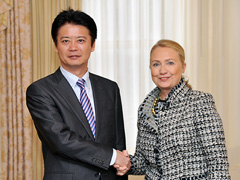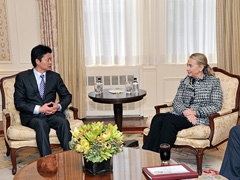Japan-U.S. Foreign Ministerial Meeting (Summary)

(Photo: Cabinet Public Relations Office)
(Photo: Cabinet Public Relations Office)
On September 28, from 10:50 a.m. (EST) for approximately 20 minutes, Minister for Foreign Affairs Koichiro Gemba held a meeting with U.S. Secretary of State Hillary Clinton during his visit to New York to attend the UN General Assembly. The outline of the meeting is as follows (Attending on the U.S. side were Assistant Secretary of State Campbell and Department of State Director of Policy Planning Sullivan. Attending on the Japanese side were Director-General of the Asian and Oceanian Affairs Bureau Sugiyama, Director-General of the Foreign Policy Bureau Hiramatsu and Director-General of the North American Affairs Bureau Ihara):
1. Japan-U.S. Relations
Regarding the MV-22 Osprey, Foreign Minister Gemba said that the Government of Japan had completed procedures for confirming its safety and that functional check flights were being conducted. He requested Secretary Clinton to continue to give maximum consideration to its safety.
2. Asia-Pacific Regional Issues
(1) China
Touching upon the current situation surrounding the Senkaku Islands, Foreign Minister Gemba explained Japan’s basic position that while it cannot concede to China’s own assertions , Japan intends to address the issue in a calm manner with creativity and ingenuity without losing sight of the broader perspective of the Japan-China relations.
Secretary Clinton briefed Foreign Minister Gemba on the exchanges at the U.S.-China Foreign Ministerial Meeting held on September 27. In any event, both sides confirmed that the two countries will cooperate under the bilateral partnership based on the Japan-U.S. Alliance.
(2) Korean Peninsula
Foreign Minister Gemba stated that although difficult problems exist between Japan and the Republic of Korea (ROK), the two ministers agreed to communicate closely at their bilateral meeting on September 27.
Both sides shared the view that a strong partnership among Japan, the U.S., and the ROK is important given the current situation in the East Asian region.
Back to Index
